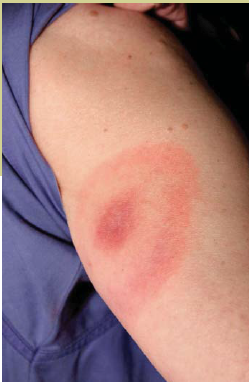
CONCORD, NH – Tick season is upon us once again, and the New Hampshire Department of Health and Human Services wants to remind people living in and visiting New Hampshire to take precautions to prevent being bitten by ticks and potentially exposed to Lyme disease and other tick-borne illnesses.
New Hampshire has one of the highest incidence rates of Lyme in the country.
According to the DHHS Division of Public Health Services (DPHS), there were an estimated 1,373 cases of Lyme disease identified in the State in 2015. According to the Centers for Disease Control and Prevention (CDC), there were 33,461 probable and confirmed cases in the United States in 2014, which is up from the 2013 count of 27,203 cases.

“We are coming upon one of the most active times for ticks in New Hampshire, which is important because of the diseases ticks can transmit to people, such as Lyme disease,” said Beth Daly, Chief of the Bureau of Infectious Disease Control at DPHS. “While we certainly encourage everyone to enjoy the outdoors and all our State has to offer this season, it is important for everyone to consistently take the necessary precautions to protect themselves and their families.”
DHHS recommends taking the following precautions to prevent tick bites:
- Avoid tick-infested areas such as overgrown grass, brush, and leaf litter
- Use insect repellent labeled as effective against ticks
- Wear protective clothing (long pants and long sleeves to keep ticks off skin)
- Do tick checks on yourself and family members after being outdoors
- Reduce ticks around your home by keeping grass short and removing leaf litter
- Speak with your healthcare provider if you are bitten by a tick or if you notice a large round rash anywhere on you.
Lyme disease is caused by the bacterium Borrelia burgdoferi and is transmitted to people by the bite of an infected blacklegged tick, also known as the deer tick. The greatest risk for Lyme is between the months of May and August, when the blacklegged tick is in the juvenile stage; it’s the size of a poppy seed and very difficult to detect, so individuals may be unaware they have been bitten. Ticks that transmit Lyme can also transmit other diseases, such as anaplasmosis and babesiosis. In 2015, there were 110 cases of anaplasmosis and 53 cases of babesiosis identified in New Hampshire residents. Although not as common as Lyme, both diseases can also cause serious illness.
Symptoms of Lyme disease include fever, headache, fatigue, and often a skin rash that is round and/or looks like a bulls eye. Lyme disease is treatable with antibiotics, but if left untreated can lead to severe headaches and neck pain caused by meningitis (inflammation of the protective covering surrounding the brain and spinal cord), pain and swelling in the large joints, shooting pains that may interfere with sleep, and heart palpitations and dizziness.
For more information about Lyme disease and other tick-borne diseases, visit the DHHS website or the Centers for Disease Control and Prevention website.







